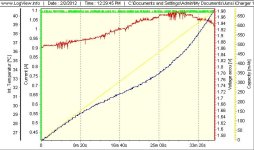cwah
100 MW
Hello there,
I was browsing ebay on NI-MH batteries and I've found these batteries:

* 100% Brand New & High quality.
* Capacity: 3800mAh
* Voltage: 1.2V
* Chemistry: NI-MH
* Dimension: CFL RECHARGEABLE BATTERY
* No memory effect
* Rechargeable Times: Up to 1000 cycle times
* For battery appliances such as emergency lighting, portable devices, power tools.
* 25 X CFL AA 3800mAh Rechargeable Battery NI-MH 1.2V
* Battery Weight: 15.6g each, Dimension 48mm in height, 13.5mm in diameter.
http://www.ebay.co.uk/sch/i.html?_nkw=3800mah+aa&_frs=1&_sop=15&_trksid=p3286.c0.m359
When I do the math, I have:
Capacity: 1.2V*3.8mAH = 4.56 Wh
Gravimetric density: 4.56Wh/0.0156kg = 292.30 wh/kg
Something is probably wrong with my math, it can't have such a high energy density.
Where did I get wrong?
I was browsing ebay on NI-MH batteries and I've found these batteries:
* 100% Brand New & High quality.
* Capacity: 3800mAh
* Voltage: 1.2V
* Chemistry: NI-MH
* Dimension: CFL RECHARGEABLE BATTERY
* No memory effect
* Rechargeable Times: Up to 1000 cycle times
* For battery appliances such as emergency lighting, portable devices, power tools.
* 25 X CFL AA 3800mAh Rechargeable Battery NI-MH 1.2V
* Battery Weight: 15.6g each, Dimension 48mm in height, 13.5mm in diameter.
http://www.ebay.co.uk/sch/i.html?_nkw=3800mah+aa&_frs=1&_sop=15&_trksid=p3286.c0.m359
When I do the math, I have:
Capacity: 1.2V*3.8mAH = 4.56 Wh
Gravimetric density: 4.56Wh/0.0156kg = 292.30 wh/kg
Something is probably wrong with my math, it can't have such a high energy density.
Where did I get wrong?







